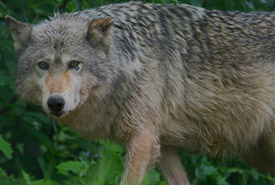
Eastern wolf (Photo by Manuel Henriques)
Eastern wolf
It’s an icy mid-winter day in Algonquin Park, Ontario. In the middle of one of the park’s numerous frozen lakes lie the remains of a deer. A bald eagle circles overhead and then, gliding gracefully, lands beside the kill as an eastern wolf silently lopes away.
A rare sight, admits Dan Kraus, the Nature Conservancy of Canada’s (NCC’s) conservation science manager for the Ontario Region. Most only ever hear the elusive carnivore, he explains. Few are lucky enough to catch a glimpse of it.
Facts:
Scientific name: Canis lycaon
Weight: 20-35kg
Pack size: 3-6 adults on average
Other names: Eastern Canadian wolf, Algonquin wolf
Home range: Can be as large as 500 km2
Species range: Current range covers approximately 210,000 km2, which represents 42 percent of its original range in Canada.
COSEWIC status: Special concern, provincially and nationally.
Did you know: Algonquin Park in Ontario has regular “wolf howls” – allowing park visitors the experience of hearing the haunting sounds of the park’s eastern wolf packs.
Genetics
For years the eastern wolf was thought to be a sub-species of the grey wolf. However, recent genetic testing has proven that Ontario is home to two distinct wolf species: the grey wolf and eastern wolf. Interestingly, the eastern wolf is more connected to the endangered red wolf of South Carolina than its Canadian cousin.
Where does it live?
Smaller than other wolves, the eastern wolf weighs between 20-35 kilograms. Found in the forests of the Great Lakes and St. Lawrence regions of Quebec and Ontario, this mottled brown canine preys primarily on white-tailed deer and moose.
Threats
Due to loss of habitat, hunting and trapping , the eastern wolf is now a species of special concern. Possible breeding with coyotes may also pose a threat to the genetic integrity of the species. This poses a unique challenge to conservation efforts, Kraus points out.
“With eastern wolves the challenge is figuring out if you are actually dealing with pure wolves, which are a species at risk, or with coyote–wolf hybrids, which are more common.”
Cross-border conservation
NCC’s Ontario Region is working to protect key wolf habitat in the Frontenac Arch Natural Area. “The Frontenac Arch is one of the major linkage projects we’re working on. It’s part of the Algonquin to Adirondack (A2A) mountain corridor,” explains Kraus. Extending from Algonquin Park to Adirondack Park in New York State, A2A is an important ecological corridor that connects the boreal forest with the Appalachian Mountains.
Kraus stresses the importance of this corridor and coordinating conservation efforts on both sides of the border so that “our work lines up with what they are doing on the U.S. side.”
Apart from scat and tracks, Kraus has yet to see any wolves in Frontenac Arch. By conserving cross-border connections and helping to increase protected lands in the Frontenac Arch Natural Area, NCC and its partners may help ensure the eastern wolf will have the land it needs to roam and thrive.
How you can help
Want to support wildlife species and their habitat? With your donation, you are accelerating the pace of conservation and helping find solutions to the twin crises of rapid biodiversity decline and climate change. Learn more >





